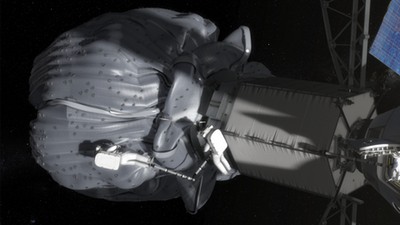It will see back in time farther
than any space telescope ever has before—back to the first light following the
big bang.
It will watch the first stars and
galaxies form.
And it will hunt for distant habitable
planets by peering into their atmospheres.
Expectations
are high for the science that will come from the $8.7 billion James Webb Space
Telescope—the successor to the Hubble Space Telescope. The telescope's four
main science instruments are now all in one place, as are its 18 mirror
sections. When assembled in space, they will create the largest orbiting mirror
ever seen.
This
long-awaited coming together is taking place in a vast clean room at the
Goddard Space Flight Center in suburban Maryland. The last pieces have arrived,
and now the two- to three-year task of assembling the telescope has begun.
On
Monday, NASA Administrator Charles Bolden, Senator Barbara Mikulski, Senior
Project Scientist and Nobel laureate John Mather, and the Webb team celebrated
this milestone. And, with equal enthusiasm, they anticipated the science that will come in once the Webb
telescope is in orbit, about one million miles from Earth.
With a
mirror six times larger in area than the Hubble's, the Webb telescope's
possibilities are dramatic:
1. The James Webb Space Telescope is
designed to see to the time when stars began to form in the universe.
Astronomers
put that time at about 300 million years after the big bang, the period when
the universe emerged from its dark ages. The Hubble has been able to see back
to 800 million years after the big bang, an unprecedented feat but considerably
less than the capability of the Webb telescope.
The
first stars in the universe are believed to have been 30 to 300 times as
massive as our sun and millions of times as bright. They would have burned for
only a few million years before dying in tremendous explosions, or supernovae.
The Webb will be able to detect the earliest of these explosions.
2. The Webb can peek inside galaxies.
The
Hubble and Spitzer Space Telescopes have already identified many tiny galaxies
that were pumping out new stars at a surprising rate more than 13 billion years
ago. These galaxies are only one-twentieth the size of the Milky Way, but they probably
contain a billion stars crammed together.
The
Webb's large mirror is designed to see longer wavelength, invisible-to-the-eye
infrared light, which can be used to see farther and to see through thick
cosmic dust. This means the telescope will be able to see into the
star-creating centers of galaxies as never before.
Webb
telescope officials describe their goal as learning about the first galaxies
when they were just babies. The Hubble telescope has been looking at toddlers.
3. Scientists now are convinced that
each galaxy has, at its center, a supermassive black hole.
The Webb
will test why and how these monster black holes came to exist. A favored theory says that the early massive
supernovae spewed out chemical elements newly formed in the first stars before
they collapsed into black holes or were destroyed.
The
newborn black holes are theorized to have then consumed the gas, dust, and
stars around them, becoming extremely bright objects called mini-quasars.
Mini-quasars are suspected to have grown and then merged to become the huge
black holes found in the centers of galaxies.
Understanding
the connection between newly formed galaxies and the supermassive black holes
at their centers would be an enormous breakthrough in astronomy.
4. The Webb will search for signs of
extraterrestrial life.
Using
the Webb telescope's spectrograph, scientists will be able to analyze the
atmospheres of the billions of exoplanets now understood to orbit stars in the
Milky Way. Depending on what chemicals are identified, researchers can come to conclusions about the
likelihood of Earth-like conditions. The presence of large amounts of oxygen or
ozone in the atmosphere, for instance, would strongly suggest that life was
present on the planet.
"We'll
be able to do so many things with the Webb that were never possible
before," Mather said at the Goddard gathering. "It will revolutionize
astronomy and, potentially, our understanding of the universe."
The Webb
telescope is scheduled to launch in 2018 from the European Space Agency
spaceport in French Guiana, and will settle at a point about four times farther
from the Earth than the moon. Fifteen nations have contributed to the effort,
and their scientists will be able to observe and discover alongside NASA's
scientists.

